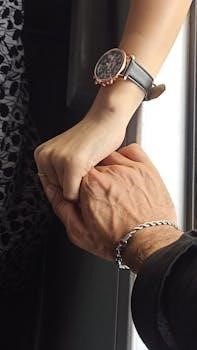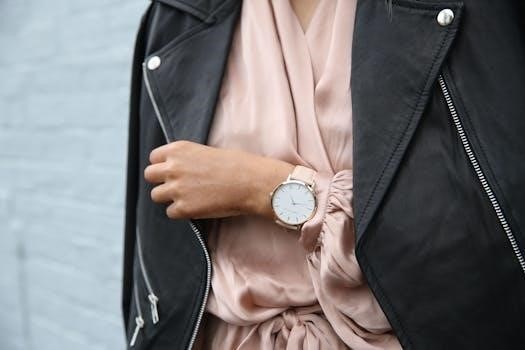Selecting the right watch size is crucial for both comfort and style. This guide helps women navigate the options, ensuring a perfect fit for their wrist. Understanding watch case sizes is the first step.
Importance of Proper Fit
A properly fitted watch enhances both comfort and aesthetics. A watch that is too large can appear bulky and slide around, causing discomfort and potential damage. Conversely, a watch that is too small can look disproportionate and be difficult to read. The ideal fit ensures the watch sits securely on the wrist without feeling tight or restrictive. A good fit also prevents the watch from catching on clothing or other objects. Furthermore, a well-fitted watch complements your personal style, adding to your overall appearance. Therefore, understanding proper fit is essential for both comfort and achieving a balanced, elegant look. It will enhance your overall wearing experience with the watch.

Measuring Your Wrist
Accurately measuring your wrist is the first step to finding the perfect watch. This ensures the watch fits comfortably and looks proportionate to your wrist.
How to Measure Wrist Circumference
To measure your wrist circumference, you’ll need a flexible measuring tape. Wrap the tape snugly around your wrist, just below the wrist bone, where you would typically wear a watch. Make sure the tape is lying flat against your skin, without any slack. Note the measurement where the tape overlaps. Alternatively, if you don’t have a measuring tape, you can use a piece of string or strip of paper. Mark where the string overlaps, then measure the length of the string or paper with a ruler. This measurement in inches or centimeters is your wrist circumference, which is essential for selecting the right watch case size and strap length for comfort and style.
Average Female Wrist Size
The average wrist size for women typically ranges from 5 to 7 inches (approximately 15 to 17.8 cm). This range serves as a general guideline when choosing a watch.
Typical Range for Women’s Wrists
While the average female wrist size falls between 5 and 7 inches, it’s important to acknowledge individual variations. Some women may have wrists that measure smaller or larger than this typical range. Generally, a wrist circumference of about 6 inches (15 cm) is considered quite common. Variations in wrist size can be influenced by factors such as body frame, age, and genetics. When selecting a watch, it’s best to measure your specific wrist size rather than relying solely on averages. This ensures a more comfortable and proportionate fit, enhancing both the look and feel of the timepiece on your wrist, allowing for a more personalized choice.

Watch Case Size Guide for Women
Understanding watch case sizes is vital for finding the right fit. Women’s watches typically range from 26mm to 40mm and beyond, offering options for various styles and preferences.
Small Cases (26mm-29mm)
Watches with small cases, typically ranging from 26mm to 29mm in diameter, offer a delicate and classic look, making them ideal for women with petite wrists or those who prefer a more subtle accessory. These smaller sizes are often considered traditional and are a great fit for individuals seeking a refined and understated style. The smaller case size ensures the watch does not overpower the wrist, providing a comfortable fit for everyday wear. These watches are a great choice for those who prefer a dainty and elegant feel on their wrist. They are often favored for their timeless appeal and discreet presence.
Medium Cases (30mm-36mm)
Medium-sized watch cases, generally between 30mm and 36mm, offer a versatile option for women, striking a balance between elegance and visibility. This size range is widely popular as it suits a variety of wrist sizes and personal styles, neither too small nor overwhelmingly large. Medium cases provide a good balance of functionality and fashion, making them suitable for both everyday wear and special occasions. This range is a common choice for women seeking a watch that is both practical and stylish, providing an appropriate presence on the wrist without being too flashy. Many women find that watches in this range fit comfortably and look proportional.
Larger Cases (38mm-40mm and beyond)
Larger watch cases, typically 38mm to 40mm and beyond, have gained popularity among women who prefer a bolder, more contemporary look. These sizes make a statement and offer enhanced readability, appealing to those who prioritize functionality along with style. While traditionally, smaller sizes were favored for women’s watches, larger cases have become a fashion trend, offering a striking presence on the wrist. This trend reflects a shift towards more expressive and less conventional styles. However, it’s important to consider wrist size to ensure that a larger case doesn’t look disproportionate. Larger cases can provide a more sporty or modern appearance.

Factors Affecting Watch Size Choice
Beyond wrist size, personal style, and preferences play a significant role in choosing a watch. Consider your lifestyle and the overall aesthetic you want to achieve with your timepiece.
Personal Style and Preference
Ultimately, the best watch size for you is a matter of personal taste. Some women prefer smaller, more delicate watches that blend seamlessly with their attire, while others gravitate towards larger, bolder timepieces that make a statement. Consider the types of outfits you typically wear and the overall look you wish to project. Do you prefer a classic, understated style or a more modern, fashion-forward aesthetic? Your choice should reflect your individual personality and make you feel confident and comfortable. Don’t be afraid to experiment and try on different sizes to see what resonates with you the most. Remember, there are no strict rules, just personal preferences.
Watch Band and Strap Considerations
Beyond case size, the watch band or strap significantly impacts fit. Length and adjustability are key for comfort. Materials like leather, metal, and nato offer various styles and feel.
Length and Adjustability
The length of a watch band or strap is crucial for a comfortable fit. It should neither be too tight nor too loose, allowing the watch to sit securely on your wrist without sliding around. Many watches come with adjustable straps or removable links, which allow you to customize the length to your wrist size. Leather straps often have multiple holes, while metal bracelets can be adjusted by adding or removing links. Consider the adjustability features when selecting a watch to ensure a comfortable and secure fit. A well-fitted strap prevents the watch from feeling cumbersome and enhances the overall wearing experience.

Traditional Placement of Watches on Wrists
Historically, women, like men, have typically worn watches on their non-dominant hand, often the left. This practice stems from the ease of winding watches with the dominant hand.
Left vs Right Wrist Preference for Women
While tradition suggests women wear watches on their left wrist, primarily due to historical reasons related to winding mechanisms, the choice ultimately comes down to personal preference and comfort. There’s no strict rule dictating which wrist a woman should choose. Some women find it more comfortable or convenient to wear their watch on their right wrist. Factors such as whether you are left or right handed and your daily activities can influence your decision. The key is to select the wrist that feels most natural and allows the watch to be worn comfortably without hindering movement. The most important factor is that you feel comfortable and happy with your choice, so experiment to see what works best for you.


